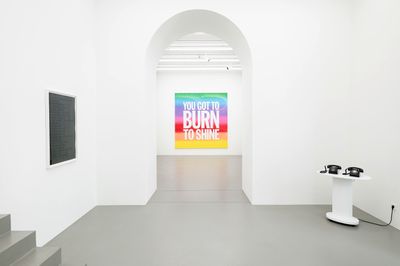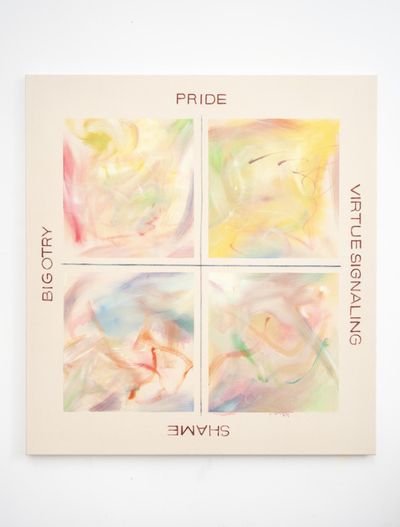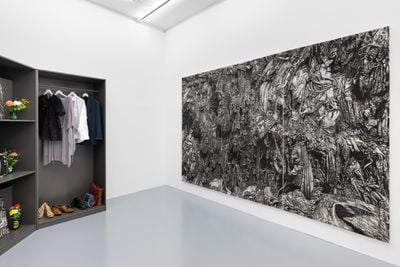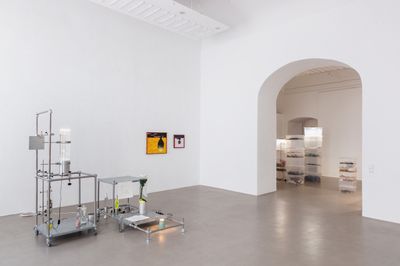
07 Oct Six Shows Not to Miss in Vienna’s ‘Curated By’ Festival
Source Credit: Content and images from Ocula Magazine. Read the original article - https://ocula.com/magazine/features/vienna-must-see-exhibitions-curated-by-2024/
Now in its 16th year, ‘Curated by’ is Vienna‘s festival of contemporary art, which pairs international curators from the U.S., Germany, Ghana, and beyond with 25 galleries to present a series of shows across the city.
The programme, which is this year themed around ‘Untold Narratives’, launched last month in the throes of severe rain and gale-force winds, with temperatures plummeting to single digits. We endured 40 wet and windy hours on the ground to pick out six exhibition highlights from the festival, all on view through 19 October.
Exhibition view: John Giorno, God Complex, Galerie Eva Presenhuber, Vienna (13 September–19 October 2024). © John Giorno Foundation. Courtesy the artist and Galerie Eva Presenhuber, Zurich/Vienna. Photo: Jorit Aust.
John Giorno: God Complex
Curated by Giorno Poetry Systems
Galerie Eva Presenhuber, Lichtenfelsgasse 5
The spirit of the late American artist and poet John Giorno is resurrected with unapologetic exuberance in a show organised by Giorno Poetry Systems—a New York-based non-profit which Giorno founded in 1965 to support artists, poets, and musicians. Honouring Giorno’s poetic mode of address, co-curators Krist Gruijthuijsen and Giorno Poetry Systems director Anthony Huberman each wrote a letter to the artist in lieu of a press release, which can be read here.
Giorno boldly pushed language within visual, musical, and sociopolitical spheres. At Galerie Eva Presenhuber, you’ll find text paintings on rainbow or black backgrounds with wry, provocative slogans like ‘You got to burn to shine’, ‘I want to cum in your heart’, and ‘God is man made’. Dial the old-fashioned telephone by the entrance (DIAL-A-POEM (Push-Button Edition), 1968–2019) to hear poems and dialogue from an illustrious list of creative minds—among them Kathy Acker, John Cage, and Eileen Myles—in what nostalgically feels like a direct line to 1970s New York.
Akeem Smith, Dovecote (2020). Two-channel video with sound, custom wrought steel, paint. 280 x 226 x 45.7 cm. Exhibition view: Dovecote, SOPHIE TAPPEINER, Vienna. Courtesy the artist and SOPHIE TAPPEINER. Photo: kunstdokumentation.com.
Akeem Smith: Dovecote
Curated by Kyle Thurman
SOPHIE TAPPEINER, An der Hülben 3
At SOPHIE TAPPEINER is a single work by Akeem Smith, Dovecote (2020): a pair of rusty, ornate, wrought-steel gates between which is sandwiched a set of double-sided screens playing archival Jamaican dancehall footage, from the collection of VHS tapes and DVDs that the artist has accumulated since 2008. Video recording the ecstatic faces of dancing women is slowed down and blown up to disconcerting proximity. This is accompanied by audio that compiles soundtracks from funeral services for the people memorialised in Smith’s video archives. The cage-like gates were originally window coverings—in Jamaican residences, signifiers of security and of class or protection versus entrapment. It’s a confident, commanding install that illuminates the intersections of architecture, social space, and digital archive.
Pauł Sochacki, The Matrix of Bourgeois Art (2023). Oil on canvas. 130 x 120 cm. Courtesy © Pauł Sochacki.
Crime as Ornament
Curated by María Inés Plaza Lazo
Crone Wien, Getreidemarkt 14
Austrians’ appreciation for ornamentation and design was first made apparent to me upon my arrival at Vienna Airport, where the immigration officer repeatedly commented on my ‘beautiful passport’ while thumbing back and forth through its pages. Originally a lecture delivered in 1910 by Austrian architect Adolf Loos, ‘Ornament and Crime’—considered a formative essay in the advent of modernism—is the premise of a group exhibition at Crone curated by María Inés Plaza Lazo. (A section of the nearby Leopold Museum is dedicated to Loos’ work.)
Featuring eight artists—Havîn Al-Sîndy, Shilpa Gupta, Ayham Majid Agha, Marcel Odenbach, Noara Quintana, Pauł Sochacki, Kandis Williams, and Philip Wiegard—Lazo’s show challenges Loos’ castigation of ornament as a ‘degenerative tendency’ of the aristocracy and his parallel exoticisation of such forms of expression in so-called simple cultures. It’s a sentiment probed in a disarmingly playful way in Pauł Sochacki’s painting The Matrix of Bourgeois Art (2023)—a four-quadrant diagram that questions the values of art.
Daniel Arnan Quarshie, Kwatserekwa Mpaboa (2024). Discarded clothes, shoes, and bags, analogue television, discarded glass bottles, synthetic flowers, charcoal drawings on canvas; Into the Badlands (2024). Charcoal on canvas. 240 x 360 cm. Exhibition view: THE ALLEGORY OF DECOY, Galerie Hubert Winter, Vienna (14 September–19 October 2024). Courtesy the artist and Galerie Hubert Winter. Photo: Simon Veres.
The Allegory of Decoy—Art as Decoy for Social and Political Change
Curated by blaxTARLINES
Galerie Hubert Winter, Breite Gasse 17
Ghanaian art collective blaxTARLINES, headed by Kwaku Boafo Kissiedu and Nuna Adisenu-Doe, brings together seven artists at Galerie Hubert Winter: Akosua Odeibea Amoah-Yeboah, Kelvin Haizel, Gideon Hanyame, Ibrahim Mahama, Afrane Makof, Daniel Arnan Quarshie, and Tracy Naa Koshie Thompson. It’s an exhibition that embodies the intergenerational, transcultural, and exchange-based ethos of the blaxTARLINES network, which advocates for and implements local and global initiatives towards growing and sustaining critical contemporary practice in Ghana.
A memorable pair of works by Quarshie, a former student of Kissiedu’s at Kwame Nkrumah University of Science and Technology in Kumasi, occupy the gallery’s end room: a wardrobe of clothing and objects belonging to the artist’s late parents offer a raw, introspective exploration of grief; while an adjacent large-scale charcoal drawing renders abstract a mountain of textile waste in Accra, the final resting place of much of the world’s fashion excess.
Left to right: Lazar Lyutakov, Richard Hawkins, Evelina Jonsson. Exhibition view: Play It As It Lays, Charim Galerie Wien, Vienna (17 September–19 October 2024). Photo: Flavio Palasciano.
Play It As It Lays
Curated by Kristian Vistrup Madsen
Charim Galerie Wien, Dorotheergasse 12
Berlin-based writer Kristian Vistrup Madsen curates seven artists (Christopher Aque, Inge Grünwaldt Svensson, Richard Hawkins, Evelina Jonsson, James Richards, Lazar Lyutakov, and Megan Francis Sullivan) in an exhibition of painting, sculpture, installation, and video titled after Joan Didion’s 1970 novel which reflects upon the cultural schism in America at the end of the 1960s. In keeping with this era, formalism and Land art are recurring motifs throughout the show at Charim Galerie, amid the undertones of California melancholy, obsession, and nihilistic grief.
The result is a laboratory-like experience with unexpected humanist moments: Richards’ spread of medical paraphernalia and self-testing kits laid across the floor at the start of the show illustrate a curious portrait of a hypochondriac (Found Objects and Self Diagnosis Kits, 2018–ongoing); an installation by Lyutakov features a number of readymade and self-made lava lamps (1 Million Random Numbers #T4, #T5, 2024). Madsen asks in his curatorial essay: ‘What if what we see when gazing into a lava lamp, into ourselves, is not infinity but precisely its limit: nothing?’
Agnes Scherer, Strawfires (2019/2024). Mixed-media installation. Dimensions variable. Courtesy the artist and MEYER*KAINER, Vienna.
Agnes Scherer: Strawfires
Curated by Eva Birkenstock
MEYER*KAINER, Eschenbachgasse 9
The installation and paintings of Salzburg-based artist Agnes Scherer at MEYER*KAINER might evoke the ritualistic oddities of an Ari Aster film: a folksy trio of freestanding, portal-like sculptures with heads poking through (ornate guillotines), cane baskets filled with eggs and babies (the abandoned Romulus and Remus), a rudimentary paper runway, and processions of partially robed figures playing French horns against dappled, cerulean backdrops in a suite of ornamental paintings.
Scherer’s protagonist is Marie Antoinette, who is staged across a series of speculative scenographies that juxtapose her life in the feudal structure against a prospective pastoral existence. The paintings feature the farm village Hameau de la Reine, which the French queen had constructed at the Château de Versailles in 1783. Curator Eva Birkenstock explains Scherer’s proposition in the exhibition text as speaking, on the one hand, ‘to the recurring overwriting of revolutionary agendas by neo-feudal demands for power, privilege, and profit maximisation. On the other hand, the title refers to a socially romantic desire for a fairer existence within the broader societal context’. —[O]
Curated by runs in Vienna until 19 October 2024.
Source Credit: Content and images from Ocula Magazine. Read the original article - https://ocula.com/magazine/features/vienna-must-see-exhibitions-curated-by-2024/






